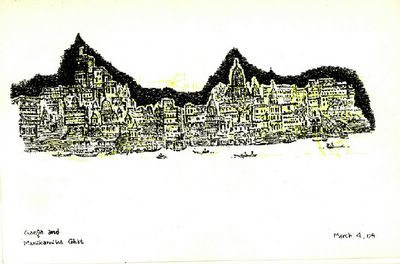Varanasi, also known as Benares or Kashi, in the northern India is one of the most ancient cities of India and the oldest continually inhabited city in the world. Varanasi is regarded as India's religious and spiritual hub, which is in many senses a microcosm of India. Sometimes tourists remember that Mark Twain described it as "Older than history, older than tradition, older even than legend and looks twice as old as all of them put together." Varanasi is the city which cannot be described, only experienced.
I had stayed at Shanti guest house when I traveled in Varanasi. This budget guest house is very famous among backpackers. Shanti means peace in Sanskrit. But the building used to be a jail during the British rule in India. Indian political offenders or anti-British activists for national independence were imprisoned here. Why did British rulers set a jail in the center of Varanasi ? It seems like that they expected it to produce some psychological effects on Indians. After being liberated from British rule, the last owner of the building altered this into a guest house and built three more stories.
My room was on the highest floor and I often enjoyed the view from the rooftop. Because the area along Ghat is densely populated with residential homes that don't have enough spaces for living, the roofs are mostly used as effective living spaces and our neighborhood is overlooked by the rooftop of the guest house. I sketched the above one, facing Alamgir mosque and Malviya bridge along Ganga river.
One of the old stone-made buildings along the western bank of Ganga in Varanasi is Munshi Ghat. About 100 ghats are in Varanasi. Most ghats are used for bathing but they have also a few for cremation. Maharajas and the other princely Rulers all over the country own them as their second homes in this holy city and usually stay here during their pilgrimage to Varanasi. Munshi Ghat on the right sits along the western bank of Ganga.
One of the oldest and most sacred Ghats in Varanasi, Manikarnika is the main burning ghat. View from the eastern Ganga in Varanasi. The black one over the buildings is described as smoke from the burning dead bodies in Manikarnika Ghat, the famous crematorium in Varanasi.Dasashvamedh is the main Ghat among about 100 ones on the western bank of Ganga in Varanasi, India. This Ghat is always crowded with Indians, tourists, dogs, goats, cows, buffalos, monkeys, crows, pigeons, donkeys and so on.
You can find easily this kind of small shop in India. It seems like that this type is the original form of a convenience store. All kinds of goods such as snacks, mineral water, Cokes, cigarettes, candles, biscuits, candies, chocolates, noodles, incense sticks, lighters, chewing gums, or whatever are available here. Sometimes the owner cleans the ground around the shop because the street is always dusty and messy. A broom is seen on the ground.
Popularly known as Alamgir Masjid(mosque) or Dharhara Masjid', it was built in the 17th century by emperor Aurangzeb(1658-1707), son of Shah Jahan (the builder of Taj Mahal), located above Panchaganga Ghat along the western bank of Ganga river in Varanasi, India. Aurangzeb destroyed most of the Mandir(Hindu temple)s during his reign. This Masjid is a blend of the Hindu and Muslim styles of the architecture.
Aurangzeb didn't tear down the previous Mandir totally, but left the base and built a mosque on it in 1669. The lower part of the decorated bricks was the base of the demolished Mandir. Many mosques were built on the sites of Mandirs during his reign, which has resulted in the fundamental tension and conflict between the two religions in India. The back of this Masjid shows a good example of ancient Hindu art.








